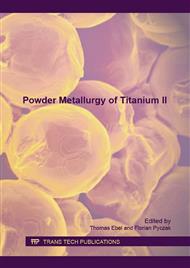p.241
p.251
p.260
p.271
p.282
p.287
p.293
p.302
p.311
Induction Plasma Technology Applied to Powder Manufacturing: Example of Titanium-Based Materials
Abstract:
Powder metallurgy technologies require specific powders to ensure a good quality to the manufactured parts. The critical properties are; the powder chemistry, flow ability, packing density, and the absence of porosity. This review highlights the capability of Tekna’s Inductively Coupled Plasma (ICP) technology for the production of high quality powders for the additive manufacturing industry.
Info:
Periodical:
Pages:
282-286
Citation:
Online since:
August 2016
Authors:
Keywords:
Price:
Сopyright:
© 2016 Trans Tech Publications Ltd. All Rights Reserved
Share:
Citation:


